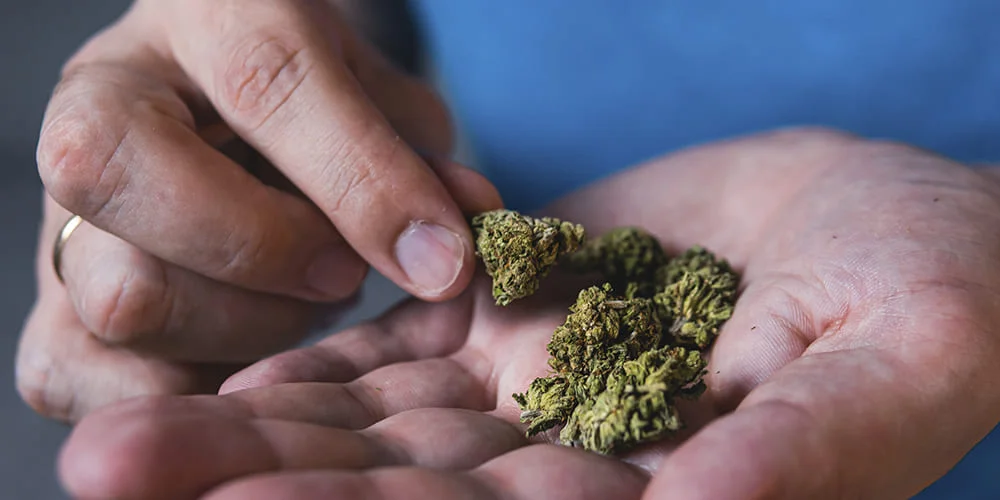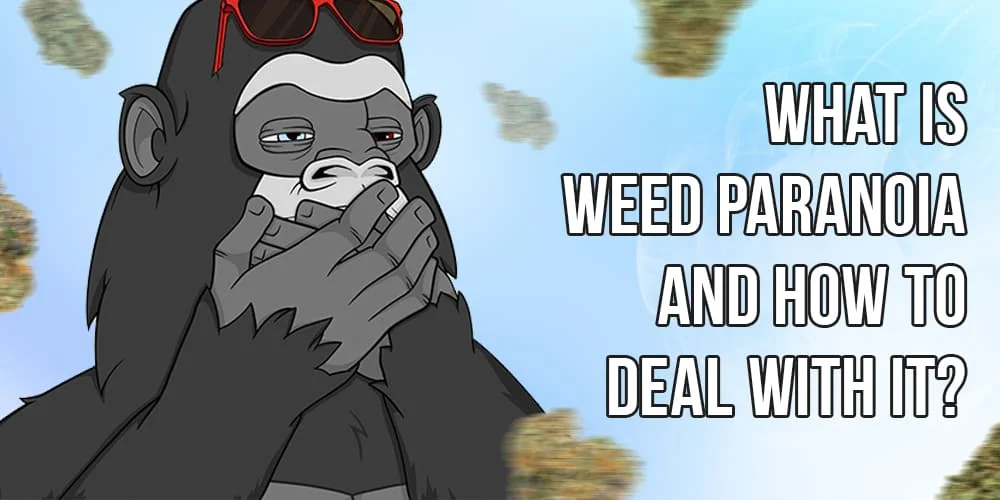In the realm cannabis, there exists a fascinating interplay between its potential to alleviate anxiety and the risk of experiencing the unsettling phenomenon known as “weed paranoia.” This delicate balance hinges on factors like the type and dosage of cannabinoids, individual genetics, and even gender.
To unravel this complex relationship, we’ll explore how cannabis interacts with our endocannabinoid system, the role of THC and CBD, and the various factors contributing to weed paranoia.
Moreover, we’ll delve into strategies to combat weed paranoia when it arises, making this journey through the world of cannabis and anxiety both enlightening and practical.
To learn more about how weed affects the body, we recommend reading these articles:
- How to detox THC naturally?
- What exactly is the magic of entourage effect?
- The Benefits of Working Out High
What Is Weed Paranoia, Exactly?

Understanding how cannabis affects anxiety is interesting. It’s tied to our endocannabinoid system (ECS), a network of receptors in our body controlling things like appetite, pain, mood, and memory.
In cannabis, THC and CBD are the main compounds. They interact with ECS’s CB1 receptors in different ways, especially in the brain. These receptors handle cognitive functions, mood, emotions, and anxiety.
Bonnie Johnson, from Goodfeeding, tries to answer if weed raises or lowers anxiety. It’s a bit of both, depending on THC levels:
- Low THC signals reduce anxiety (calming).
- High THC signals can increase anxiety (worsening it).
Lower THC doses are better for reducing anxiety, highlighting the importance of careful dosing.
Now, CBD. It doesn’t directly bind to CB1 receptors but influences them, reducing THC’s effects. CBD also helps with anxiety, much like antidepressants, by affecting mood-regulating serotonin receptors.
CBD is usually easier on the body than THC, but dosage matters. Low CBD doses (5-10 mg) boost energy, while higher ones (50 mg or more) might make you sleepy. If you’re switching from sedatives to CBD, manage your dosage to avoid side effects.
Remember, especially if you’re new to cannabis, start with small doses and take it slow.
What Causes weed paranoia?

The primary culprit behind weed paranoia often boils down to improper dosing. Inexperienced users sometimes hastily consume THC-packed edibles, leading to overwhelming and distressing episodes.
Other factors contributing to weed paranoia and paranoia encompass:
- Body Composition: Individuals with lower body mass indexes (BMIs) may experience intensified marijuana effects.
- Prior Anxiety and Mood Conditions: A history of such conditions can heighten susceptibility to cannabis-induced anxiety.
- Strain Characteristics: Some strains, erroneously categorized as sativas, feature high levels of compounds like THCV, CBG, and limonene, potentially provoking more stimulating effects.
For individuals mulling over cannabis consumption, especially those with a history of anxiety or mood disorders, consulting with a healthcare professional is a prudent step.
If you’re well-versed in strains, select one conducive to relaxation during meditation. If unsure, consider Lemon Cherry Gelato in Sauce Cart, known for its tingly, relaxed, and euphoric effects. Medical users find relief from anxiety, pain, and stress.
Alternatively, explore the Strawberry Banana strain – a kief-infused delight with sugar diamonds. Ignite it for a magical experience, inducing happiness, peace, creativity, and heightened sensory awareness.
Why Some People Are More Affected by Cannabis?

Weed paranoia is not a universal experience with cannabis use, and several factors contribute to its occurrence:
Genetics: Research suggests that the brain’s front region, rich in reward-producing opioid receptors, plays a role in how cannabis affects an individual. Those with heightened THC sensitivity in the brain’s rear region may be more susceptible to adverse reactions like weed paranoia.
THC Content: Cannabis with higher THC levels is more likely to induce paranoia and other negative effects. Studies reveal that lower doses, approximately 7.5 milligrams of THC, can reduce negative emotions related to stress. Conversely, higher doses, such as 12.5 milligrams, tend to intensify these negative feelings.
Sex: Studies on THC tolerance indicate that higher estrogen levels, especially in females, can increase sensitivity to cannabis by up to 30 percent and lower tolerance levels. This heightened sensitivity applies to both positive effects like pain relief and negative effects like paranoia.
Understanding these factors can help individuals assess their potential sensitivity to weed paranoia, enabling them to make informed choices when using the substance.
Dealing with weed Paranoia

Relaxation
Engage in calming activities like coloring, listening to soothing music, or taking a warm bath. Consider yoga and deep breathing exercises for added relaxation.
Pepper Aroma
Pepper contains terpenes with similarities to cannabinoids. Inhaling the scent of freshly ground peppercorns may help counteract THC’s effects. Be cautious not to get too close, as it can cause sneezing and eye irritation.
Lemon Remedy
Limonene, another terpene, could assist in mitigating THC’s impact. Create lemonade by squeezing and zesting a lemon, adding sugar or honey, and water as desired.
Optimal Environment
Establish a calming environment to reduce anxiety. If possible, retreat to a comfortable space like your bedroom or a tranquil outdoor area. If changing your surroundings isn’t feasible, try playing soothing music, cocooning in a blanket, spending time with a pet, or calling a trusted friend.
Inhalation methods, such as vaping or smoking, allow cannabinoids to rapidly enter the bloodstream through the lungs, providing a faster onset of effects. Therefore, you can look for something for yourself in APE Vape section of our catalog.
Avoiding Weed Paranoia: Tips and Tricks

When dealing with cannabis and anxiety, it’s crucial to be cautious, especially if you’re new to weed. Rushing into high THC doses, particularly with potent products, can lead to severe panic attacks.
The main rule is not to consume more weed than your body can handle. While your tolerance may increase with time, the goal is to find the right THC dose, along with other compounds, that suits your needs.
In conclusion, the journey through the intricate landscape of weed and anxiety reveals a multifaceted relationship. While medical cannabis can offer relief and relaxation for many, the potential for weed-induced paranoia underscores the importance of responsible usage.
By understanding the nuances of THC and CBD, considering individual factors such as genetics and body composition, and embracing relaxation techniques and natural remedies like pepper and lemon, individuals can navigate the realm of medical marijuana more confidently.
Remember, the key lies in finding the right balance and dosage to harness the therapeutic benefits of cannabis while mitigating the risk of unwanted anxiety.
Ultimately, informed choices and patience are essential as one explores the potential of medical cannabis for various chronic conditions, offering hope for a more comfortable and anxiety-free experience.


























